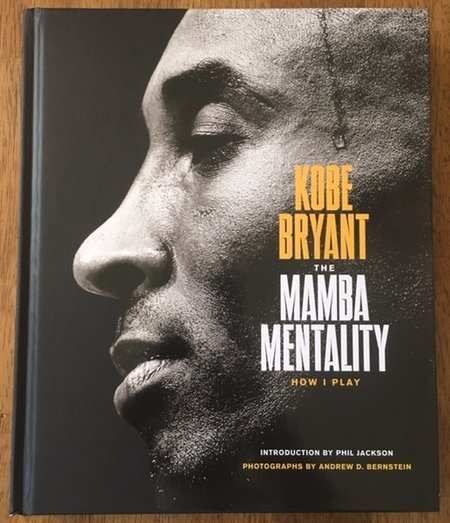 It was the spring of 2009.
It was the spring of 2009.
The NBA playoffs were heating up, and every basketball fan was eager to see the matchup of two generational talents:
Kobe Bryant versus LeBron James.
One superstar was in the middle of his prime. The other was just entering his own.
It was destiny in the making. Fate was bringing these two together:
- The Cavaliers won a franchise-record 66 games, LeBron won his first MVP award, and the Cavs swept through the first two rounds of the playoffs.
- Kevin Garnett, a member of my beloved Boston Celtics, suffered an injury that crippled the Lakers’ rival and removed a juggernaut from LeBron’s path.
- Nike even released a series of commercials featuring puppet versions of Bryant and James.
All the stars were aligned for this great historical matchup.
But then, the unthinkable happened…
LeBron lost.
The Cavaliers lost the first game of the conference finals at home, and then succumbed to the Dwight Howard-led Magic in 6 games.
Now I, like the rest of the basketball world, was disappointed. This was our best chance to see two top ten players in NBA history face off in the Finals.
But it didn’t happen. And it never would.
“Just give him his ring now.”
That was my attitude going into the Finals. I knew Kobe’s Lakers were far too much for the rising Magic.
Part of me didn’t even want to watch the series—and that says a lot coming from a basketball junkie—but once I finally did tune in, I was hooked.
Yes, Kobe and the Lakers destroyed the Magic. They won the series 4 games to 1. But this wasn’t your typical steamroll, particularly on Kobe’s part.
It wasn’t, “I’m going to dominate because I’m more talented than you.”
It was planned. It was methodical. It was…cerebral.
This wasn’t just an athlete performing at a high level. This was a mind toying with the competition.
Kobe had a counter for every scheme and a punishment for every mistake. You could even see the light dim in the eyes of Magic defenders after each consecutive basket.
Now I always knew Kobe could go off—he had already dropped 81 on Jalen Rose’s head—but this was the first time I saw him lead a team with such incredible shotmaking on that big a stage.
LeBron James, Mike James, Rick James, it wouldn’t have mattered, Kobe was getting that ring.
And even though I couldn’t explain what I saw then, that younger me caught his first glimpse at a mindset that inspired countless players around the world:
The Mamba Mentality.
The Mamba Mentality: How I Play
So what is this Mamba Mentality?
It depends on who you ask.
Most in the basketball community will say it’s about relentless aggression (and selfishness). Others blow it off as a useless meme.
But the term “Mamba Mentality” stems from a hashtag that Bryant—nicknamed the Black Mamba—started on Twitter.
The phrase quickly grew to embody Kobe’s playstyle and thought process. And its popularity in the basketball world, as well as in popular culture, led to the creation of Bryant’s new book, The Mamba Mentality: How I Play. (Affiliate link)
I was excited to learn more about the fabled mindset from its source. So I got my hands on a copy as soon as it released.
The book begins with a foreword from former teammate, Pau Gasol, and an introduction from former coach, Phil Jackson.
Bryant then proceeds to give a macro view of his mentality, and later details thoughts on specific moments and matchups from his career.
The book is also a collection of gorgeous pictures from photographer Andrew D. Bernstein. Those pictures allow you to relive the journey through Kobe’s career and understand exactly what he’s describing in each moment.
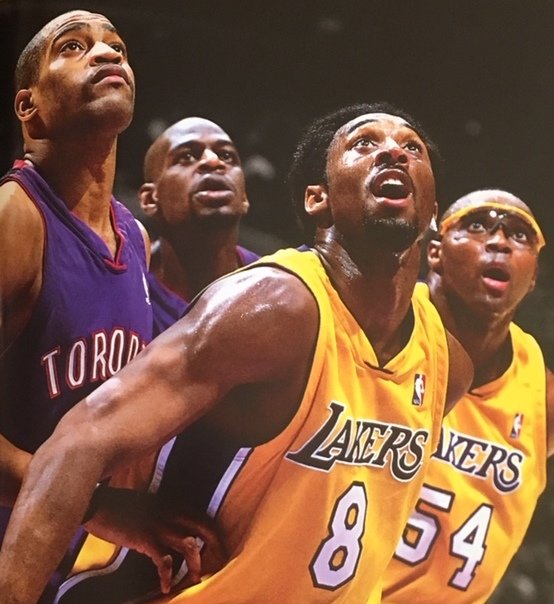
I personally loved the book’s structure. It caters to basketball fans but it’s also accessible enough for those who don’t follow the sport.
But if I had to name one disappointment with the book, it would be its length. The hardcover edition was 200+ pages but most of that is covered by the pictures I mentioned earlier.
I finished the book over a weekend and was left wanting a little more.
But overall, I enjoyed it. I found Kobe’s mindset to be contagious and—I say this in a non-boastful way—similar to my own.
So I thought I’d share 8 actions (and 24 quotes!) from The Mamba Mentality to help you on your quest to mastery.
#1 Immerse
My mindset was: I’m going to figure you out. Whether it was AI, Tracy, Vince—or, if I was coming up today, LeBron, Russ, Steph—my goal was to figure you out. And to that, to figure those puzzles out, I was willing to do way more than anyone else. (pg 22)
Almost immediately, Kobe describes the one trait the Mamba Mentality was born from:
Obsession.
But I’ve never liked that word. It has an unhealthy connotation and paints the image of a madman who cares for nothing other than his work.
That’s why I prefer the word immersion.
You have to immerse yourself in your specific field in order to reach your potential.
You have to dive head first and let it flow all around you. You can’t just sit on the edge and dabble your toes.
But no matter what word you use to describe it, the fact is, you have to give it your all.
Kobe knew this. It’s one reason why he had such a ridiculous workout schedule:
…if I started at 5AM and went until 7, I could go again from 11 until 2 and 6 until 8. By starting earlier, I set myself up for an extra workout each day. Over the course of a summer, that’s a lot of extra hours in the gym. (pg 26)
 Kobe made a schedule and stuck to it. That’s how he racked up all the hours.
Kobe made a schedule and stuck to it. That’s how he racked up all the hours.
Yes, it’s easy to work in 6 hour bursts when you first start. Excitement will carry you when it’s fresh. But it’s hard to that when you’re months down the road.
A disciplined schedule will help you when your motivation wanes. And it will give you a rhythm you’ll never want to lose.
Kobe didn’t just plan his workouts around himself though. This schedule also allowed him to be with his family.
He got to see them in the morning after the first workout and then again between the second and third. The only downside was that he lost sleep. But that was the one sacrifice he was willing to make.
People think you need to be a hermit to be great at what you do. But all you really need is immersion and balance.
When describing that balance between his craft and the rest of his life, Bryant says:
It’s akin to walking a tightrope. Your legs are shaky and you’re trying to find your center. Whenever you lean too far in one direction, you correct your course and end up overleaning in the other direction. So, you correct by leaning the other way again. That’s the dance. (pg 33)
It’s difficult to master your craft and be there for the ones you love—but it is possible. So please don’t neglect either one.
#2 Prepare
I never thought about my daily preparation. It wasn’t a matter of whether it was an option or not. It was, if I want to play, this is what I have to do, so I’d just show up and do it. (pg 42)
Examples of preparation are found all throughout Mamba Mentality. And this particular one explains how Bryant had an edge before the games even started:
I made a point of reading the referee’s handbook. One of the rules I gleaned from it was that each referee has a designated slot where he is supposed to be on the floor.
…I would get away with holds, travels, and all sorts of minor violations simply because I took the time to understand the officials’ limitations. (pg 67)
Who does that?
No, who even thinks to do that?
I was content to let officials do their job when I played. I never thought about learning how they were told to do it.

But another, more mainstream approach to preparation was Bryant’s film study:
From a young age—a very young age—I devoured film and watched everything I could get my hands on. It was always fun to me. Some people, after all, enjoy looking at a watch; others are happier figuring out how the watch works. (pg 28)
It’s easy to get tunnel vision and only review your own performance. But one of the best ways to prepare is to watch, read, or listen to the work of others.
You can’t just do it for entertainment though. You have to be a student, not a fan:
Film study eventually became imagining alternatives, counters, options, in addition to the finite details of why some actions work and others don’t work. (pg 28)
The biggest change Kobe noticed in film study was that he started looking for ways to improve what he saw. He stopped consuming it for its own sake.
You have to make that same change.
I for one have a difficult time reading blogs and books I used to enjoy. My mind always wanders with “that sentence structure could be better” or “she should have used a stronger verb there.”
I think about all the options available to writers and how I would have used them if it was my work. There were even times when I wanted to edit the wording in this book to make it flow better—no offense, Kobe.
But that’s what great preparation does.
It gives you a toolbox beyond your experience and creates endless possibilities.
#3 Stay Aggressive
A lot of times, with a lot of guys, the defensive player becomes the attacker and the offensive player capitulates to that. I never approached it that way. When I went to the basket, I was attacking and I wasn’t the one at risk of getting hurt: they were. (pg 109)
If there’s one thing Kobe and his Mamba Mentality are known for, it’s aggression.
Kobe was one of the most aggressive shot-chuckers I’ve ever seen. It didn’t matter if he missed five straight shots before then. He continued to attack without shame.
This attitude led many fans to see him as the epitome of selfishness, especially in the first half of his career.
It’s even a running joke that Kobe reached two career highs the day he scored 81:
81 points, and 2 assists.
I always respected his shameless style though. Convincing yourself to hold back is always better than needing motivation to push forward.
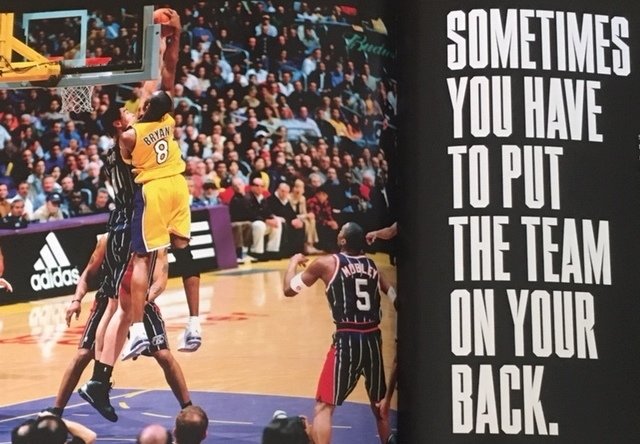
Kobe wasn’t totally responsible for this this mindset though. He had help from a big friend:
The one thing I specifically picked up from Shaq was his physicality, his brute force. Despite being a guard, I wanted players to be sore, to be beat up, after guarding me for 48 minutes. That would give me the mental advantage the next time we matched up. (pg 114)
And if you watched Kobe play, you know this rough style didn’t just give him a mental advantage. It let him live at the free throw line too.
Aggressive and proactive work always leads to benefits. The luckiest people are usually the ones who just do more than anyone else.
But on those days when you won’t feel so “lucky,” you’ll still need that effort too.
In one section of the book, Kobe described his encounters with Kevin Garnett—a notorious trash talker—and how he responded to him:
He knew that when he talked crap to some guys, it would faze them out of their game. And he knew that when he talked smack to others, they would level up. I fit in the latter category, and he knew that, so he never directed one word of trash talk to me. (pg 120)
Instead of laying down or even ignoring trash talk, Kobe used it as fuel to grow. And his reputation for facing those challenges head on shielded him from the mental games others tried to play.
Adversity is opportunity in disguise. It’s an opportunity to rise above.
This constant fight against adversity defined Bryant’s career. And even when his challenges became more than mental, he responded with a focused and mischievous approach:
…you have to be willing to play through that. More than that, it has to excite you on some level. You have to take it as a challenge, like, Go ahead and be physical but trust me, you’re going to back down before I do. (pg 150)
#4 Master the Basics
Follow the rules now so you know which ones to break later.
That’s the best advice for beginners in any field.
I know the rules and the basics are boring but there’s a reason they were put in place. They’re best practices for the majority of situations you’ll encounter.
For example, small paragraphs, short sentences, and active voice are essential for internet writing. Yes, there are exceptions to each of those, but for the most part, they’re standard practice.
Nothing frustrates me more than seeing an interesting topic buried within a wall of text. The author didn’t follow the basics of writing short paragraphs and his words lost their influence because of it.
Writing, and blogging in particular, has endless creative options. But if you don’t use the fundamentals, people won’t stick around to see them.
Bryant also spoke on the importance of fundamentals and how they gave him an advantage:
It’s weird, actually—fundamentals aren’t really fundamental anymore. A lot players don’t understand the game or the importance of footwork, spacing. It’s to the point where if you know the basics, you have an advantage on the majority of players. (pg 116)
And instead of relying solely on the flashy skills he had when he was younger, Kobe took a different approach:
During my early years in the NBA, I was surprised to learn that I took a different, more fundamental and serious, approach to footwork than a lot of players.
…Only after mastering pivots—reverse pivots, inside reverse pivots, outside reverse pivots—did I work on the sexier between-the-legs, behind-the-backs, and crossovers. (pg 105)
Mastering the basics helped Bryant build a mature game early in his career. It also allowed him to combat his physical decline en route to 20 seasons—when most of his peers had long since retired.
#5 Self-Assess
What separates great players from all-time great players is their ability to self-assess, diagnose weaknesses, and turn those flaws into strengths. (pg 197)
One of the most important skills any craftsperson can have is the ability to assess their own work.
It keeps you humble, it fosters improvement, and it builds confidence when warranted.
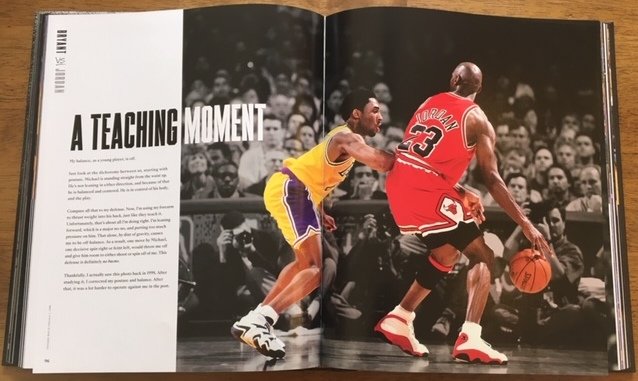
As a blogger or writer, I always feel there’s room to improve. I don’t even feel comfortable calling myself a writer yet. That’s how much I still have to learn.
I’ve always been my toughest critic. So when people compliment my work, I struggle to believe them.
Out of the 50 posts I’ve published on this site, there’s only about 20 I feel good about. The rest have gone through numerous edits and they’re really just up now so you can see the progression. That and because I don’t feel like writing on the same stuff again.
Being naturally self-critical is both a blessing and a curse. But that honesty is always needed.
One particular game in Kobe’s career led him to self-assess. And that moment would ultimately lead to the first string of championships in his career:
At the end of my first season in the NBA, we had made it to the Semifinals, up against Utah. But in the deciding fifth game, I let fly four airballs, and we lost our chance at the title. Those shots let me know what I needed to work on the most: my strength. (pg 123)
Then he followed up with the most valid solution: hitting the weights.
You’ll never succeed at your craft, or in life, if you can’t be honest with yourself and improve your weaknesses.
It doesn’t matter how much time you spent doing things the wrong way. Either edit that work or scrap it. Then keep moving forward.
#6 Adapt
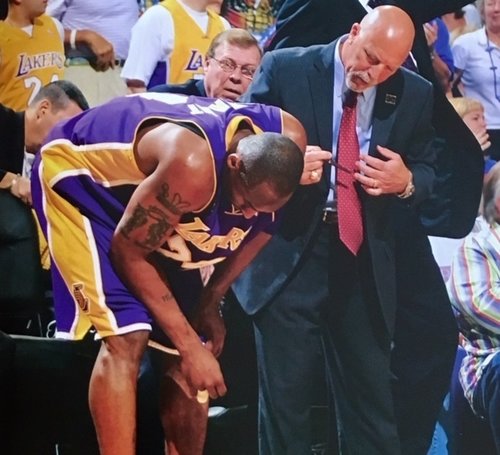 Kobe got injured…a lot.
Kobe got injured…a lot.
He was a far cry from the tank that is LeBron James.
I always thought that made Kobe relatable though…well, as relatable as a 6’6” NBA superstar can be.
He talks about his many injuries in the book as well, but what’s interesting is that he never described self-pity or being overly concerned about setbacks:
Over the course of 20 seasons, I suffered my fair share of serious injuries. The first thing I always thought about in those situations was, “What do I need to do to get back to 100 percent?” That was my mindset. I never let fear or doubt set into my psyche. (pg 172)
But what’s also notable is his attitude towards adapting to, and playing with his injuries:
Once I established my limitations, I’d adjust my gameplay accordingly. Occasions like that are why you need to have a well-rounded game, why you need to be able to do everything with both hands, off of either foot, whether you’re 30 feet from the basket or in the post. (pg 172)
Kobe got to the court before the game, tested out his body, and then decided how to play. Many times he wouldn’t be at his best physically—and who would be over the course of an 82 game season?
But instead of letting those limitations hold him back, he adapted by using the other tools in his arsenal.
That’s one reason why it pays to be an all-around player or content creator:
Versatility is the best contingency plan.
But as another testament to Bryant’s adaptive nature, he also explained how he changed his shooting form after fracturing his finger in 2009:
Up until then, I’d always shot off of my first two fingers. After I hurt it, I had to start focusing on using my middle finger. The middle became my point of release, and I had to sort of let my index finger drift. (pg 70)
As a former player myself, I know how difficult that is. Just jamming your finger will affect your shot and other on-ball actions. So I can’t imagine how much a fracture would affect my play.
Shooting with weight primarily on the middle finger isn’t natural. It would take thousands of shots just for it to feel comfortable, let alone to compete at such a high level.
But hey, we’re talking Kobe here.
#7 Simplify
One of the biggest criticisms I’ve seen of Mamba Mentality is that it isn’t in depth.
Yes, the book is illustrative and somewhat detailed, but it doesn’t have the step-by-step, “do this, not that” approach some readers expected.
I think that’s a good thing though. And after reading Kobe’s words, I believe it was intentional:
Coaches are teachers. Some coaches—lesser coaches—try telling you things. Good coaches, however, teach you how to think and arm you with the fundamental tools necessary to execute properly.
…Good coaches tell you where the fish are, great coaches teach you how to find them. (pg 62)
This quote obviously describes Bryant’s opinion on coaching styles. But it seems to be his philosophy on teaching as well.
People like Kobe can give you a mindset. And yes, they can give some specialized advice. But no one’s gonna hold your hand. You have to follow through.
A person who always needs step-by-step advice doesn’t have the internal drive to do enough on their own.
That’s why I believe Kobe simplified much of the book. He wants to give a decision-making framework without paralyzing the reader with “what ifs?”.
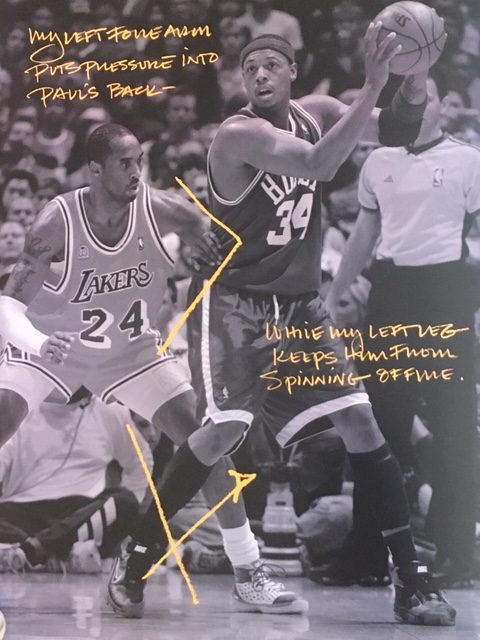
You can see this mindset at work in his attitude towards minor injuries:
“Will it get worse if I play through it?” If it was going to be painful but not get worse, I’d deal with it 100 percent of the time. That was the only thought process for me. (pg 172)
Sharp, concise, to the point. If there was no chance he’d hurt an injury further, he’d always play though the pain.
These are the quick decisions Bryant encourages.
Simplicity isn’t just about making fast decisions though. It also diminishes the fear associated with them:
I wasn’t scared of missing, looking bad, or being embarrassed. That’s because I always kept the end result, the long game, in my mind. I always focused on the fact that I had to try something to get it, and once I got it, I’d have another tool in my arsenal. (pg 22)
In other words, he did the work, and he got rewarded.
Kobe knew he had to give something valuable to get something valuable. That’s just the way it works.
Sometimes that “give” part may be a little uncomfortable—but it is worth it:
- You may have to blog for over a year before you hit your stride and gain steady traffic.
- You may have to scrap your first two ideas because the third is the best.
- You may have to work early mornings because the evenings are too hectic.
But no matter what, you just have to do it. Because once you do, it will all feel the same:
People make a huge deal out of clutch shots. Thing is, it’s just one shot. If you make a thousand shots a day, it’s just one of a thousand. Once you’re hitting that many, what’s one more? That was my mentality from day one. (pg 102)
#8 Reach Out
 No one lives in a bubble.
No one lives in a bubble.
There is nothing you can or ever will do that hasn’t been done in some fashion before.
That’s why you have to reach out.
I know that can be difficult, especially for introverts like myself. But it is necessary.
Other people have done what you’re trying to do. And you’ll only waste time trying to do it alone.
Kobe reached out to those he wanted to learn from. And even though the results weren’t always in his favor, he kept asking:
They appreciated that I wasn’t just asking to ask, I was genuinely thirsty to hear their answers and glean new info. Some people, meanwhile, were less understanding and gracious. That was fine with me. My approach always was that I’d rather risk embarrassment now than be embarrassed later, when I’ve won zero titles. (pg 40)
Some people don’t care to help others. Some people are eager to do it. But you’ll never know if you don’t approach them.
I know rejection is a scary thing, but once you get shot down the first time, each new rejection will sting even less. And those small moments of shame will always be better than wondering “what if?”.
But never forget that there’s another answer too, because the people who do say “yes” may have a profound impact on your life:
Just as important as reading was cultivating relationships with the greats who’d come before me. As evidence of this, look at my retirement ceremony and who was there. That will tell you how I managed to get my jersey up there. You had Bill Russell, Kareem Abdul-Jabbar, Magic Johnson, Jerry West, James Worthy. Those guys taught me the lessons that gave me an edge over my competition. (pg 29)
Remember that mentors are in high demand and they can’t help if you don’t bring something to the table. But when you’ve reached the point where you’ve done all you can do, reach out, and then see how far you can all go together.
Build the Foundation
 After years of watching Kobe play and getting a chance to read his book, I can easily tell you what the Mamba Mentality is:
After years of watching Kobe play and getting a chance to read his book, I can easily tell you what the Mamba Mentality is:
A foundation.
It’s a mindset that blends a serious approach with a hint of playfulness, and detail with unexpected simplicity.
Once that foundation is set, all you’ll need is the follow through.
So remember these 8 actions to be great at whatever you do. Then you can build a hall of fame career of your own.
And if you’d like to read more from The Mamba Mentality: How I Play, you can purchase your copy here.
-Drew
Have you ever thought about including a little bit more than just your articles? I mean, what you say is fundamental and all. But think of if you added some great graphics or video clips to give your posts more, “pop”! Your content is excellent but with images and videos, this site could certainly be one of the best in its field. Wonderful blog!
Yeah, I’ve been trying to find a balance with that recently and I’m always looking to change things up. Thanks for the suggestion and the kind words.
So I’ve just heard the news about Kobe’s passing and it’s a little hard to process now. I’m a huge Celtics fan, and Kobe was one of the guys I loved to root against, but I also respected him as one of the greatest to ever do it.
I loved writing this post and I hope it serves as a good tribute to his career, life, and legacy.
RIP Mamba.